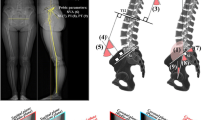Abstract
Sagittal balance of the spine is becoming an important issue in the assessment of the degree of spinal deformity. On a standing lateral full-length radiograph of the spine, the plumb line, or sagittal vertical axis (SVA), can be used to determine the spinal sagittal balance. In this procedure patients have to adopt a habitual standing position with the knees extended during radiographic examination, though it is not known whether small changes in the position of the lower extremities affects the location of the SVA. The purpose of the present study was to investigate the effect of postural change on shifts of the SVA, and to evaluate whether the SVA as measured on a standing full-length lateral radiograph can be used as an accurate measurement of spinal balance in clinical practice. Sagittal balance was analyzed using a patient with ankylosis of the entire spine due to ankylosing spondylitis, to eliminate segmental movement of the spine. A virtual SVA was constructed for seven different standing postures by cross-referring the coordinate systems from a standing full-length lateral radiograph of the spine with video analysis. The horizontal distance between the SVA and the anterior superior corner of the sacrum was measured for each posture. Small changes in the joint angles of the lower extremities affected the SVA significantly, and resulted in the horizontal distance between the SVA and the anterior superior corner of the sacrum varying from –4.5 to +14.9 cm. High correlations were found between this distance and the joint angle of the hip (r = –0.959), knee (r = –0.936), and ankle (r = 0.755) (P < 0.01). The results of the study showed that SVA translations during standing radiographic analysis in a patient with a fixed spine depend on small changes in the hip, knee, and ankle joints. Thus, sagittal spinal (im)balance in ankylosing spondylitis can not be measured from the SVA on a standing lateral full-length radiograph of the spine unless strict procedures are developed to control for the angle of the hip, knee, and ankle joints. The accuracy of the SVA as a measurement of sagittal spinal balance in other spinal deformities, with possible additional segmental movements, therefore remains questionable.
Similar content being viewed by others

Author information
Authors and Affiliations
Additional information
Received: 10 December 1997 Revised: 8 May 1998 Accepted: 25 May 1998
Rights and permissions
About this article
Cite this article
Van Royen, B., Toussaint, H., Kingma, I. et al. Accuracy of the sagittal vertical axis in a standing lateral radiograph as a measurement of balance in spinal deformities. E Spine J 7, 408–412 (1998). https://doi.org/10.1007/s005860050098
Issue Date:
DOI: https://doi.org/10.1007/s005860050098



